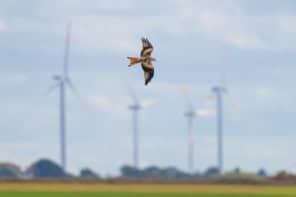
A painstaking study of sensor-laden European starlings has confirmed what scientists have long suspected: birds use significantly less energy when they fly behind a leader. The study, which was carried out by an interdisciplinary team of researchers in the US, is the first to measure birds’ in-flight energy expenditure directly, and team co-leader Ty Hedrick thinks the findings could have implications for other bird species, too.
“There’s nothing particularly ‘special’ about a trio or pair of starlings that would lead us to believe that we’d find the effect in them but not in (for example) small shorebirds,” says Hedrick, a biologist at the University of North Carolina, Chapel Hill who conducted the work alongside postdoctoral researcher Sonja Friman and colleagues in physics and engineering departments at the University of Massachusetts Amherst, Brown University, Howard University, the Rochester Institute of Technology and the University of Southern California, Los Angeles. According to Hedrick, the energy savings he and his colleagues identified may even apply to birds that fly in dynamic flocks, not just those that adopt the familiar, fixed V-formation used by geese and other large migratory species.
First, catch some starlings
To measure how a starling’s position in a flock affects its energy use, Hedrick, Friman and colleagues needed three things. The first was a controlled flying environment big enough to accommodate up to three starlings without compromising their safety or impeding their natural flight. The team found this at Brown, which operates a purpose-built, mesh-enclosed animal flight wind tunnel with an active volume 1.2 m wide, 1.2 m tall and 2.8 m long.
The second thing the researchers needed was a way to monitor the starlings’ movements in flight. They achieved this by fitting the birds with miniature backpacks containing inertial measurement units (IMUs) and different-coloured LEDs. The IMUs recorded three-dimensional data on the birds’ linear accelerations and angular velocities, while the LEDs helped the team distinguish the positions of individual birds on video recordings of test flights.

The final ingredient was a means of measuring the starlings’ energy use. For this, the researchers injected the birds with a dose of sodium bicarbonate that contained carbon-13. This non-radioactive isotope of carbon is often used as a label in metabolic testing because biological processes preferentially take up carbon-12 atoms, which are lighter. By placing the starlings in a metabolic chamber and using a spectrometer to monitor the 13C/12C ratio in their exhaled breath before and after flights, the team could therefore calculate how much energy the birds used.
Together, these three elements enabled the team to go beyond previous bird-flight studies that measured biomechanical and physiological correlates of energy use, but not energy itself, Hedrick says. “The effect of formation flight on flight costs has been investigated for so long and in so many ways, but we realized that the existence of a large animal flight wind tunnel and the new ‘turn-key’ equipment for doing the metabolic measurements would let us go after the question experimentally in a way that had not been done before,” he tells Physics World.
“A lot of effort”
Even with the latest equipment, things did not always go to plan. “The most challenging part was getting everything to work together at once,” Hedrick says. “We needed two (or three) birds to fly well in the wind tunnel, all of the inertial measurement unit backpacks to function at least well enough to provide the bird ID light colours, and the 13C sodium bicarbonate metabolic measurement to work as well.”
As for what happened when things went wrong, the materials and methods section of the team’s paper makes illuminating reading. Data from several test flights had to be discarded after birds “repeatedly veered toward the floor, attempted to land on the floor or cameras, or clung to the front or rear mesh” of the wind tunnel. Noise from whirring feathers masked the indicator tones meant to help synchronize IMU data with video images. And of course, the researchers needed to catch the birds cleanly and transfer them to the metabolic chamber quickly to avoid messing up the post-flight 13C/12C readings. “All of these things are pretty likely to [work] on their own, but getting them to all work at once took a lot of effort from a skilled and dedicated research team,” Hedrick says.

Simple equation predicts how quickly animals flap their wings
The reward for this effort was twofold. First, the researchers found that when a starling spent most of a test flight in a “follower” position, it expended up to 25% less energy than it did when flying solo. Second, they noticed that the most energy-efficient solo flyers were far more likely to adopt the “leader” role when flying with other birds. The researchers say that this difference is likely related to the birds’ wing-flapping frequency, which was generally lower for “leader” birds. A more complete explanation, however, will require additional experiments.
“The next thing we’d really like to do is directly visualize the wake interaction between a lead bird and a follower using digital particle image velocimetry to get a better understanding of the fluid dynamic mechanism that produces the energy savings,” Hedrick says.
The research is published in PNAS.



